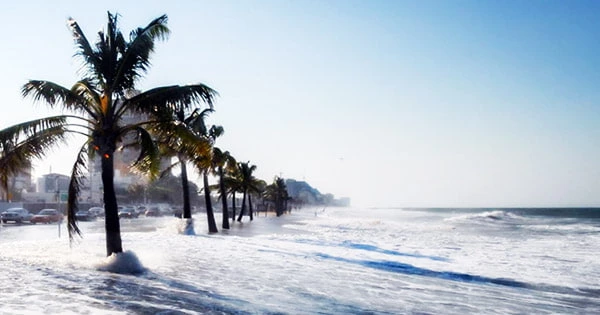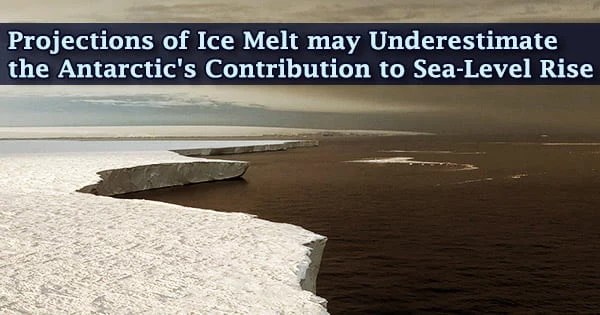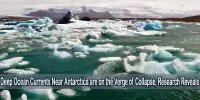According to Penn State scientists, weather fluctuations can have a substantial impact on melting Antarctic ice, and models that do not account for this element may underestimate the worldwide impact of sea-level rise. If all of the ice in the world’s glaciers and sheets melted, the sea level would rise by 216 feet.
“We know ice sheets are melting as global temperatures increase, but uncertainties remain about how much and how fast that will happen,” said Chris Forest, professor of climate dynamics at Penn State. “Our findings shed new light on one area of uncertainty, suggesting climate variability has a significant impact on melting ice sheets and sea-level rise.”
While it is well understood that continued warming could result in rapid ice loss, the team of scientists pointed out that models that predict how Antarctica will respond to climate change have not taken into account the potential impacts of internal climate variability, such as yearly and decadal climate fluctuations.
The addition of water from melting ice sheets and glaciers, as well as the expansion of saltwater as it warms, are the primary causes of sea-level rise due to global warming. The first graph depicts the change in sea level as measured by satellites since 1993.
The second graph, which was created using data from coastal tide gauges and satellites, illustrates how much sea level has changed between 1900 and 2018. Pluses (+) represent variables that cause the global mean sea level to rise, whereas minuses (-) represent variables that cause sea levels to fall. These items are depicted during the time when they had an impact on sea level.
The scientists recently revealed in the journal Climate Dynamics that accounting for climate variability leads models to forecast an additional 2.7 to 4.3 inches (7 to 11 cm) of sea-level rise by 2100. Without climate variability, the models predicted a rise in sea level of 10.6 to 14.9 inches (27 to 38 cm) over the same time period.

“That increase alone is comparable to the amount of sea-level rise we have seen over the last few decades,” said Forest, who has appointments in the departments of meteorology and atmospheric science and geosciences. “Every bit adds on to the storm surge, which we expect to see during hurricanes and other severe weather events, and the results can be devastating.”
Mountain glaciers and other large ice formations naturally melt a little in the summer. In the winter, snowfall, largely from evaporated seawater, is usually enough to counteract melting.
We know ice sheets are melting as global temperatures increase, but uncertainties remain about how much and how fast that will happen. Our findings shed new light on one area of uncertainty, suggesting climate variability has a significant impact on melting ice sheets and sea-level rise.
Chris Forest
However, rising temperatures induced by global warming have recently resulted in higher-than-average summer melting as well as reduced snowfall due to later winters and earlier springs. This causes a mismatch between runoff and ocean evaporation, resulting in rising sea levels.
The Antarctic ice sheet is a complex system that necessitates thousands of simulations and a lot of computational capacity to estimate how it will evolve under future climate circumstances. As a result, modelers use a mean temperature calculated by averaging the results of climate models to see how the ice will react.
However, the scientists claim that this approach smooths out peaks generated by climate variability and reduces the average number of days above temperature thresholds that potentially affect ice sheet melt, biasing the results.
The increased heat is forcing the vast ice sheets that cover Greenland and Antarctica to melt more fast, similar to mountain glaciers. Scientists believe that meltwater from above and seawater from below are seeping beneath Greenland’s ice sheets, essentially lubricating ice streams and helping them to travel faster into the sea.
“If we include variability in the simulations, we are going to have more warm days and more sunshine, and therefore when the daily temperature gets above a certain threshold it will melt the ice,” Forest said. “If we’re just running with average conditions, we’re not seeing these extremes happening on yearly or decadal timescales.”
The researchers looked at two large ensembles of climate simulations to see how internal climatic variability affected the results. Large ensembles are created by randomly assigning slightly different initial circumstances to each member.
According to the scientists, the chaotic nature of the climate system causes each member to have slightly different responses, which they call internally generated variability.
The scientists incorporated atmospheric and oceanic data representing this variability into a three-dimensional Antarctic ice sheet model instead of averaging the results of each ensemble. They discovered that atmospheric fluctuations had a greater and more immediate impact on the ice sheet, although ocean variability also had a role.
Significant swaths of the ice sheet are in touch with ocean water, and prior research has revealed that warming oceans might cause large portions of the ice sheet to break away. The process could expose ice cliffs that are so high that they fall under their own weight, causing a domino effect that depletes the ice shelf even more.
Model simulations that did not account for internal climatic variability delayed ice sheet retreat by up to 20 years and underestimated future sea-level rise, according to the researchers.
“This additional ice melt will impact the hurricane storm surges across the globe. Additionally, for years, the IPCC reports have been looking at sea level rise without considering this additional variability and have been underestimating what the impact may be,” Forest said. “It’s important to better understand these processes contributing to the additional ice loss because the ice sheets are melting much faster than we expected.”
This study was financed by the National Science Foundation and the Penn State Center for Climate Risk Management.
















